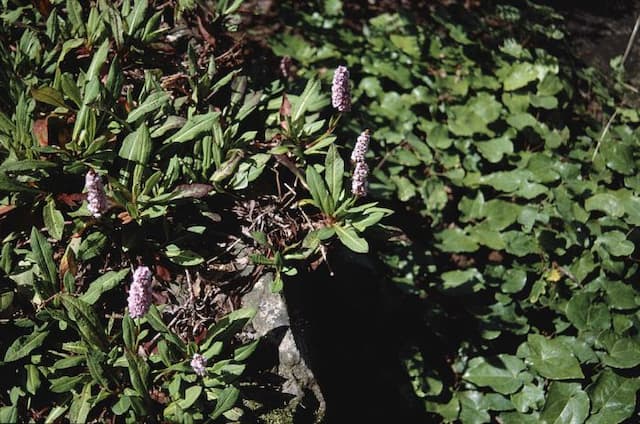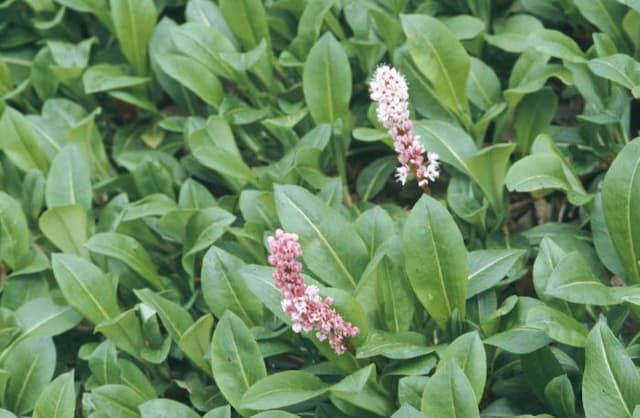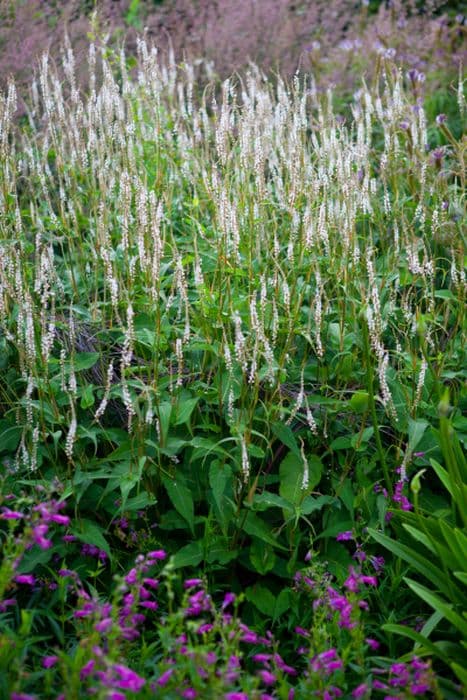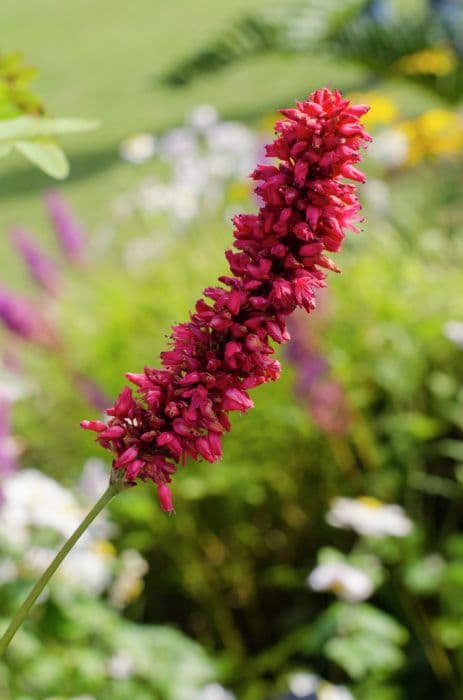Red bistort Persicaria amplexicaulis

ABOUT
The plant commonly known as "Mountain Fleece" is characterized by its spiky, elongated flower clusters that display a range of colors from pink to red. Its blooms emerge atop leafy, upright stems, creating a brush-like appearance. The leaves of Mountain Fleece are broad, with a glossy texture, and clasping around the stem to which they are attached. They are often rich green in color, adding a lush backdrop to the vibrant flowers. The overall form of the plant is bushy, as it produces numerous stems and leaves, resulting in a full and abundant look. This growth habit enables it to create a dense and striking presence in garden settings.
About this plant
 Names
NamesFamily
Polygonaceae
Synonyms
Red Bistort, Mountain Fleece, Bistort
Common names
Bistorta amplexicaulis, Polygonum amplexicaule, Persicaria amplexicaule.
 Toxicity
ToxicityTo humans
The Persicaria amplexicaulis, commonly known as Red Bistort or Mountain Fleece, is not known to be toxic to humans. There is no widespread documentation of poisonous effects resulting from ingesting parts of this plant. As with many plants, individual sensitivities can vary, and it is generally advisable to refrain from consuming any plant material that is not known to be safe or intended for human consumption.
To pets
The Red Bistort, or Persicaria amplexicaulis, does not have a reputation for being toxic to pets. There is limited information suggesting it may cause harm if ingested by animals such as dogs or cats. However, pet owners should always exercise caution and prevent pets from eating ornamental plants as individual reactions can vary, and not all possible toxicities may be well-documented. If a pet exhibits unusual symptoms after consuming any part of a plant, it is important to consult a veterinarian.
 Characteristics
CharacteristicsLife cycle
Perennials
Foliage type
Deciduous
Color of leaves
Green
Flower color
Varies
Height
3-4 feet (0.9-1.2 meters)
Spread
2-3 feet (0.6-0.9 meters)
Plant type
Herb
Hardiness zones
5
Native area
Himalayas
Benefits
 General Benefits
General Benefits- Attractive Flowers: Persicaria amplexicaulis produces elongated clusters of small, vivid flowers that add color to gardens from midsummer to autumn.
- Pollinator Friendly: The flowers are attractive to bees and butterflies, promoting biodiversity in the garden.
- Low Maintenance: Once established, it requires minimal care, making it a good choice for gardeners of all skill levels.
- Deer Resistant: The plant is not preferred by deer, which makes it suitable for areas with deer pressure.
- Moisture Tolerant: It thrives in moist soils and can tolerate wet conditions, making it ideal for waterside plantings or rain gardens.
- Fast Growing: It can fill in garden spaces quickly, providing a lush, full look in a short period of time.
- Drought Tolerance: Despite its love for moist soils, it exhibits some drought tolerance once established.
- Long Bloom Season: With a flowering period that lasts several months, it provides prolonged visual interest in the garden.
- Architectural Structure: The tall, upright stems and often large leaves of Bistort add structure and form to garden designs.
 Medical Properties
Medical Properties- Anti-inflammatory: Persicaria amplexicaulis has been known to exhibit anti-inflammatory properties.
- Antioxidant: The plant contains compounds that may act as antioxidants, helping to protect cells from damage.
 Air-purifying Qualities
Air-purifying QualitiesThis plant is not specifically known for air purifying qualities.
 Other Uses
Other Uses- In natural dye production: Persicaria amplexicaulis can be used to create natural dyes for textiles, due to the pigments found in its leaves and stems.
- As a soil stabilizer: The plant's extensive root system helps to prevent soil erosion on steep slopes and along water banks.
- Companion planting: It can be used in companion planting to benefit other plants in the garden, potentially deterring certain pests due to its strong scent.
- In pond margins: The plant is suitable for planting around pond margins, where it can provide shelter and habitat for amphibians and insects.
- As a cut flower: With its attractive spikes of flowers, Persicaria amplexicaulis adds an unusual architectural element to floral arrangements.
- In wildlife gardens: It can be used to attract pollinators such as bees and butterflies, contributing to the biodiversity of a garden.
- Educational use: The plant can be included in educational gardens to demonstrate the variety of flowering plants in the Polygonaceae family.
- Photographic subject: Due to its vivid blossoms, it's a popular choice for plant photography and botanical illustration.
- In culinary presentation: While not typically eaten, the flowers may be used as an edible garnish to add color to salads or desserts (it's important to ensure flowers are free from pesticides and are indeed edible).
- As a living fence: When planted in rows, it can create an informal, living boundary that can offer privacy while incorporating natural beauty into landscaping.
Interesting Facts
 Feng Shui
Feng ShuiThe Red bistort is not used in Feng Shui practice.
 Zodiac Sign Compitability
Zodiac Sign CompitabilityThe Red bistort is not used in astrology practice.
 Plant Symbolism
Plant Symbolism- Resilience: Persicaria amplexicaulis, commonly known as the Mountain Fleece Plant, typically symbolizes resilience due to its robust and hardy nature, capable of thriving in many conditions.
- Prosperity: The abundant and lengthy blooming period of the Mountain Fleece Plant can represent prosperity, as it produces a profusion of flowers over a long season.
- Connection to Nature: With its wild appearance and easiness to grow, the Mountain Fleece Plant is often associated with a strong connection to the natural world and a reminder of the beauty of wild flora.
 Water
WaterThe Mountain Fleece, Persicaria amplexicaulis, should be watered regularly, especially during dry periods, to keep the soil consistently moist but not waterlogged. In general, watering with approximately 1 gallon per plant once a week during the growing season should suffice. During very hot or dry weather, you may need to water twice a week. It's important not to let the soil dry out completely between watering sessions. Ensure that the water penetrates deeply into the soil to encourage deep root growth rather than shallow watering, which can lead to weak root systems.
 Light
LightThe Mountain Fleece prefers full sun to partial shade conditions. The ideal spot for this plant would be a garden area that receives sunlight for at least 6 hours a day. However, some relief from intense afternoon sun can help prevent scorching of the leaves in especially hot climates.
 Temperature
TemperatureMountain Fleece is hardy and can tolerate temperatures as low as 20 degrees Fahrenheit and as high as 85 degrees Fahrenheit. The ideal temperature range for vibrant growth and flowering is between 60 and 75 degrees Fahrenheit. Ensure the plant is not exposed to prolonged temperatures at the extremes of its hardiness range to prevent stress and damage.
 Pruning
PruningThe Mountain Fleece benefits from pruning to remove spent flowers and encourage a second bloom. Prune the plant back by one-third after the initial flowering period has finished, typically in late summer or early fall. This pruning can help maintain a neat plant shape and vigor. Additionally, you can do light pruning throughout the growing season to remove dead or damaged stems.
 Cleaning
CleaningAs needed
 Soil
SoilRed bistort prefers a fertile, moist yet well-draining soil mix with a pH range of 5.8 to 7.0. For optimal growth, mix garden loam with compost and peat moss to enhance soil structure and fertility.
 Repotting
RepottingRed bistort does not require frequent repotting as it is a hardy perennial; repotting every 3 to 4 years is sufficient to rejuvenate the soil and divide the clumps if necessary.
 Humidity & Misting
Humidity & MistingRed bistort thrives in average garden humidity conditions and does not require any special humidity adjustments for healthy growth.
 Suitable locations
Suitable locationsIndoor
Ensure bright light, moist soil, and good air circulation for red bistort.
Outdoor
Plant red bistort in partial shade, moist soil, and protect from strong winds.
Hardiness zone
4-7 USDA.
 Life cycle
Life cycleThe life of Persicaria amplexicaulis, also known as Red bistort or Mountain fleece, begins with seed germination, which occurs in warm, moist soil conditions typically in spring. Seedlings develop into juvenile plants, featuring lance-shaped leaves and a clumping form. As it matures, the plant forms a robust, bushy perennial with a deep, fibrous root system which allows it to survive through winter. During the growing season, typically from midsummer to early fall, the Red bistort produces dense spikes of small, reddish-pink flowers that attract pollinators. After flowering, seeds are produced and dispersed, continuing the cycle, while the plant itself dies back to the ground at the onset of winter. The plant then reemerges from the same root system the following spring, thus completing its perennial life cycle.
 Propogation
PropogationPropogation time
Spring to Summer
Persicaria amplexicaulis, commonly known as the Red Bistort or Mountain Fleece, is typically propagated by division, which is the most popular method for this herbaceous perennial. Division should be carried out in the spring, as soon as new growth appears, ensuring that each division has at least one growing point. To propagate by division, carefully dig up the clump of the plant, trying to keep the root mass intact. Using a sharp knife or spade, slice through the root ball to separate it into smaller clumps, each with several shoots and a portion of the root system. These divided sections can be replanted immediately at the same depth they were growing at previously, spaced about 18 to 24 inches (45 to 60 centimeters) apart to allow for growth. Water the new divisions thoroughly after planting to help establish them. This straightforward approach of dividing mature plants helps maintain the health of the plant by reducing overcrowding and stimulates new growth.





![Red bistort [Taurus]](/_next/image?url=https%3A%2F%2Fplants-admin.emdemapps.com%2Fimages%2Fplants%2F%2Fimages%2F604b548be7841.png&w=640&q=75)



